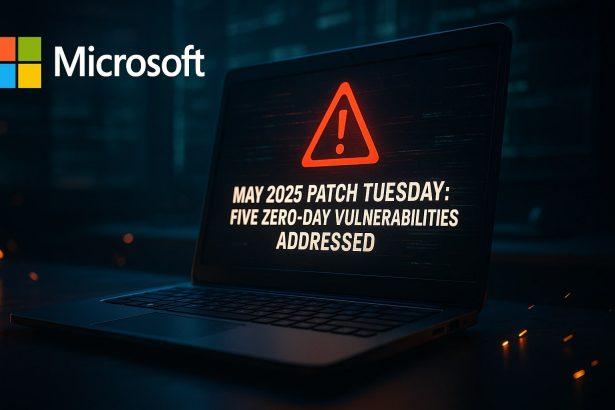In a significant move to reinforce digital security across its ecosystem, Microsoft released its May 2025 Patch Tuesday update, addressing a total of 78 security vulnerabilities. Among these, five zero-day flaws were confirmed to be actively exploited in the wild, posing an urgent threat to users and enterprises globally.
The monthly update covers critical patches across Windows, Office, Azure, and other widely deployed Microsoft products, and arrives amid heightened cybersecurity concerns following a string of high-profile exploits in recent months.
Breakdown of May 2025 Security Vulnerabilities
Microsoft’s May release includes:
- 11 Critical vulnerabilities
- 66 Important vulnerabilities
- 1 Low-severity vulnerability
The most severe issues addressed involve remote code execution (RCE), privilege escalation, and information disclosure, all of which are commonly exploited by threat actors for initial access or lateral movement within networks.
Notably, 28 vulnerabilities could lead to remote code execution, while 21 are tied to privilege escalation. An additional 16 vulnerabilities involve information disclosure, with others affecting denial-of-service and spoofing.
This diverse spread emphasizes the evolving attack surface and the need for layered defense strategies across infrastructure, endpoint, and identity-based security controls.
Five Actively Exploited Zero-Day Vulnerabilities Fixed
Of particular concern are five zero-day vulnerabilities that were already being exploited in the wild before the update. These flaws were serious enough to be included in the U.S. Cybersecurity and Infrastructure Security Agency’s (CISA) Known Exploited Vulnerabilities catalog, mandating federal agencies to apply patches by June 3, 2025.
Here are the critical details of each zero-day flaw:
CVE-2025-30397
Component: Microsoft Scripting Engine
Type: Memory Corruption
Impact: Remote Code Execution
Vector: Malicious web content
This vulnerability allows remote attackers to execute arbitrary code in the context of the user running the application. If exploited, it can be triggered through specially crafted web pages or malicious scripts, making it particularly dangerous for users browsing untrusted sites.
CVE-2025-30400
Component: Desktop Window Manager (DWM) Core Library
Type: Elevation of Privilege
Impact: SYSTEM-level Access
This flaw enables local attackers to gain SYSTEM privileges, the highest level of user rights on a Windows machine. The vulnerability lies in how the DWM Core Library handles certain requests, allowing attackers to bypass standard access controls.
CVE-2025-32701 & CVE-2025-32706
Component: Windows Common Log File System (CLFS)
Type: Elevation of Privilege
Impact: Local Code Execution with Elevated Rights
Both vulnerabilities stem from flaws in the CLFS driver. By exploiting these issues, attackers can run processes with elevated privileges, potentially leading to full system compromise. These types of vulnerabilities are often used in chained exploits after initial access is gained.
CVE-2025-32709
Component: Windows Ancillary Function Driver for WinSock
Type: Elevation of Privilege
Impact: Elevated Access for Local Attackers
This vulnerability provides an attacker with a pathway to escalate privileges via the networking stack. It could be weaponized to move laterally across a compromised network or to gain persistence on affected systems.
Inclusion in CISA’s Known Exploited Vulnerabilities Catalog
The addition of these five vulnerabilities to CISA’s KEV catalog signals their confirmed exploitation in real-world attacks and elevates the urgency for federal systems and private enterprises alike. Under Binding Operational Directive (BOD) 22-01, all federal civilian agencies are required to patch these vulnerabilities by June 3, 2025, or risk compliance violations.
This also serves as a broader warning to critical infrastructure sectors and businesses operating in regulated environments to take swift action.
Broader Security Implications
The May Patch Tuesday rollout is another reminder of the persistent and adaptive nature of threat actors targeting the Microsoft ecosystem. Given the widespread adoption of Windows, Office, and Azure cloud services, vulnerabilities in these platforms can have far-reaching consequences.
From supply chain attacks to ransomware delivery, attackers continue to exploit both overlooked system components and newly discovered flaws. Vulnerabilities in CLFS and WinSock, for example, reflect a pattern of targeting lower-level system drivers that often lack user-level visibility or logging.
Organizations need to treat these threats with the highest level of urgency. Even if no indicators of compromise are immediately visible, unpatched systems are effectively open doors for adversaries leveraging automated exploit kits or sophisticated reconnaissance tactics.
Expert Recommendations for IT and Security Teams
Security professionals across sectors agree: prompt patching is the most effective line of defense against exploitation of known vulnerabilities. However, patch management alone isn’t enough.
Here are key recommendations for enterprise and SMB security teams:
- Prioritize zero-days first: CVE-2025-30397 through CVE-2025-32709 should be patched immediately across all affected systems.
- Apply updates organization-wide: Include both user endpoints and backend systems like virtual machines, domain controllers, and on-prem cloud integrations.
- Audit systems for compromise: Use endpoint detection and response (EDR) tools to look for signs of suspicious behavior or privilege escalation.
- Update attack surface reduction rules: Strengthen Group Policy Objects (GPOs) and endpoint hardening to reduce script-based and driver-based attacks.
- Communicate with end-users: Inform staff about the importance of patching, and consider enforced restarts or scheduled patching windows to ensure updates are fully applied.
Closing Thoughts
Microsoft’s May 2025 Patch Tuesday is a crucial security update that addresses not just routine bugs but active threatsimpacting users worldwide. With five zero-day exploits already in the wild, the window for action is narrow.
Security teams, systems administrators, and CISOs must act swiftly to prevent compromise and ensure resilience. In today’s digital landscape, failing to patch known vulnerabilities is equivalent to leaving the door open — and adversaries are always knocking.
SEO-Optimized Tags
Microsoft Patch Tuesday, May 2025 updates, CVE-2025-30397, Microsoft zero-day, actively exploited vulnerabilities, Windows security updates, Microsoft vulnerability patch, remote code execution, elevation of privilege, CISA KEV catalog, Patch Tuesday zero-day flaws, DWM vulnerability, CLFS driver flaw, WinSock security issue, system privilege escalation, critical Windows patches




